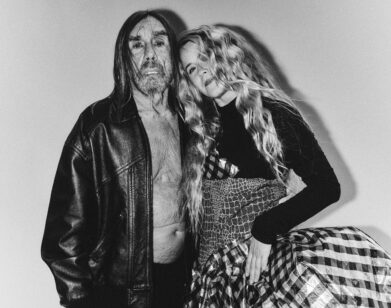A History of Violens

VIOLENS. PHOTO COURTESY OF TOM HINES
An aura of mystery—some might say suspicion—surrounds Violens. Who is this band, and why are they so hard to read? The trio, fronted by singer and lead guitarist Jorge Elbrecht, have always escaped categorization; they are artists and musicians that refuse to identify as either. A few years ago, they performed as Lansing-Dreiden, the willfully obtuse Miami-based media troupe who maintained a journal and an art gallery, and who—somewhat peripherally—released two towering, orchestral pop albums. Even as familiarity with the Lansing project grew, its masterminds remained ciphers—an impenetrability that flummoxed Pitchfork but compelled curious aesthetes.
Over time, the unit shifted locations (to Brooklyn) and priorities (to strictly music). They rematerialized in 2010 as Violens—a full-bodied rock band with a perilous moniker that signifies the stately/lethal duality of their well-regarded debut album, Amoral. A trip through the record reveals that Elbrecht and co. have grown into cryptic but purposeful pop composers. Amoral marries ’60s baroque melodies with the Paisley-powered jangly guitar haze of the early ’80s. Its cavernous wall of sound is urgent, visceral, and nebulous—meaning you can imagine your own intentions. It is music made by and for introverts.
Now in the midst of a US tour, Violens have come to embrace the stage—sort of. “I sing and play guitar. I’m not Iggy Pop, you know?” Elbrecht says of his performance style. Between shows, he told Interview what black metal and Buddy Holly taught him about making pop music—and why radio is going to be better for it.
COLLEEN NIKA: Why did Violens as a musical outlet need to exist independently from Lansing-Dreiden?
JORGE ELBRECHT: I’ve always had songs on the back burner I wanted to release; I needed a simple vehicle to do that. Once we closed the Lansing gallery—and didn’t really feel the urge to find a new space—all things related to the Lansing name were up in the air. Instead of solving that issue right now, we started fresh.
NIKA: Did you feel that the Lansing concept—as a consolidated aesthetic experience—limited your ability to simply release music?
ELBRECHT: If we had limitations, they were self-imposed. The primary difference now is that we make music we can do justice live. The music on Amoral represents how we play it onstage—two guitars, a synthesizer, three-part harmonies, and a drum kit. The Lansing sound was more expansive—orchestras on one song, bongos on the next, and difficult to perform. But I think Lansing will return one day—there’s a timeline to play with.
NIKA: What’s in your immediate future?
ELBRECHT: Touring and writing the new Violens record. Amoral took forever to complete. Lots of starts and stops—kind of a pain in the ass! We’re simplifying the process this time. We’re asking ourselves: “What would we want to hear on the radio?”
NIKA: Are you challenging yourselves to write a chart hit?
ELBRECHT: Oh yeah, I mean, the idea is cool. It’s a fun experiment, to engineer a perfect pop song. Why not?
NIKA: What are your thoughts on mainstream pop at the moment?
ELBRECHT: I don’t see much redeeming in it. A few years back, even the most commercial pop could have some artistic value. Someone who liked underground music could appreciate Justin Timberlake, too. Now, I just don’t get it. Production values are boring; songwriting has gotten worse—the choruses on a lot of popular hip-hop songs are especially bad. The rappers hit their flow in the verses, then when they try to sing, it’s a mess. And just like the airbrush tool in Photoshop, Autotune is way overused. It’s not a toy!
NIKA: Who is an unparalled songwriter?
ELBRECHT: Buddy Holly was awesome. A verse, a cool hook, a burst of a chorus, and then he’s done—and it’s fucking amazing. It makes sense that his type of melodic but efficient songwriting has prevailed over time. Tears for Fears were also doing something great—for a few albums, at least.
NIKA: You’ve also mentioned an affinity for black metal, which some may find surprising. Does Violens channel that influence?
ELBRECHT: Yes, in the way our instruments are played and our textural elements are recorded, even the synths. Black metal—especially from the ’90s—contains a certain production aesthetic that keys you into the emotive content. You feel it more intimately than, say, technical death metal, where everything is produced super-precisely. Like black metal, our musical space goes deeper, the way a My Bloody Valentine record does.
NIKA: I’m curious to learn where your fascination with the term “generational loss” stems from. It’s the title of a track—but it also pops up in the lyrics of another song.
ELBRECHT: We wanted that song to sound like it was coming off a lost cassette tape. We limited the high and low frequencies, so it was all mid-range—then we faded into a high-resolution version. The effect is supposed to be that it’s been recorded over and over on itself. In the song “Acid Reign,” that term comes up in the lyrics—it’s about how the meaning of a pop song will be lost over the generations, as the same tropes are used again and again. How can singing “I love you” sound original decades later?
NIKA: Originality in pop: where does it stand?
ELBRECHT: I think it’s nearly impossible to be original now. For anything revolutionary to happen again, new instruments have to be invented. A new kind of guitar, maybe, and a new way to play it. There are only so many ways to manipulate sound, if you look at it scientifically.
NIKA: And yet plenty of interesting music is being made—much of it in your own neighborhood of Brooklyn. Do you believe an art-pop renaissance is taking place there, or is that a blog-fueled pipe dream?
ELBRECHT: I believe it a lot more now that I actually live and record there. I feel connected to the creative community and the proximity to other bands is convenient: it’s easy to find acts to go on the road with! That said, I don’t see a lot of similarities between all the bands—just that we live in Brooklyn. Everyone is carving their own niche, including us. There’s no cohesive trend.
NIKA: Looking back, it does seem that Lansing-Dreiden presaged a few specific trends in indie music marketing. Namely, the idea of anonymity, as well as the idea of the band branding itself as an “art-making collective.” Those ideas are almost opposites—and yet both are very relevant right now.
ELBRECHT: It’s funny how that happened when we decided to simplify and just write pop songs. A lot of bands are crossing into visual art—but it goes beyond that. So many acts now need to have a “brand” to thrive—the clothing line, the soft drink, as well as the music. It’s crazy. But obscuring your identity—total anonymity—is also a hard thing to maintain for too long. We decided to drop that idea early on once a random reviewer outed my name. “Unmasking ourselves” wasn’t the big deal people made it out to be. I mean, once people can Google you, they can see what you look like, so what’s the point of hiding anymore?






